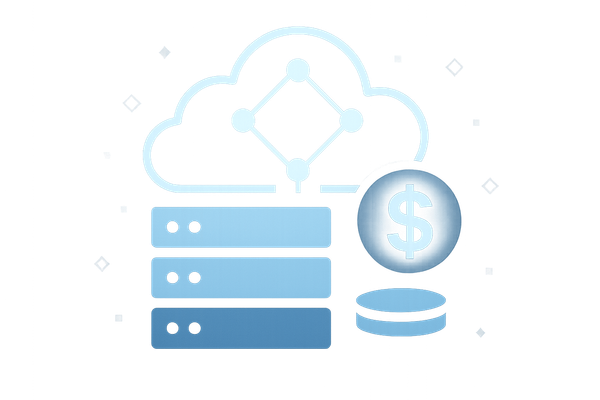How To Prioritise Workloads For AWS Migration
Learn how to effectively prioritise workloads for AWS migration, ensuring a smooth transition and minimised risks with structured strategies.

Migrating to AWS can be complex, but prioritising workloads effectively makes the process manageable and reduces risks. Start by focusing on low-risk applications, like test environments, to refine your approach before tackling critical systems. Use a structured method to assess workloads based on business impact, technical feasibility, cost, and dependencies. This ensures smoother transitions and aligns the migration with your goals.
Key steps include:
- Inventory workloads: Document all applications, including technical details and dependencies.
- Assess complexity: Group workloads into low, medium, and high-complexity categories.
- Set criteria: Prioritise based on factors like business importance, cost savings, and technical readiness.
- Plan migration waves: Begin with pilot projects, then move to core applications, saving high-risk systems for later.
AWS tools like the Migration Evaluator and Application Discovery Service can simplify the process. By adopting a phased approach, you can minimise disruptions, control costs, and build confidence in your migration strategy.
End-to-End Cloud Migration Plan from On-Premises to AWS l Free AWS Course | 30 Days | #awscourse

Creating Your Current Workload Inventory
To build a solid foundation for your AWS migration, start by creating a detailed inventory of your current workloads. This inventory serves as a roadmap, helping you make informed decisions about what to migrate first. Without it, prioritising workloads and planning your migration phases effectively becomes nearly impossible.
Make sure to include all types of applications - production, development, backup, and legacy - along with their associated business and technical details. For each, document the application name, business owner, technical specifications, and its current hosting environment.
Conducting a Complete Workload Assessment
A thorough assessment of every workload is critical. This includes production systems, development environments, backups, and older legacy systems. Assign a priority level to each workload based on its operational importance. For instance, a customer-facing e-commerce platform will likely take precedence over an internal reporting tool that's used infrequently. Also, identify the business processes each workload supports, especially those that could result in revenue loss if disrupted.
For each workload, document key technical details such as the operating system, database, storage setup, and network configuration. Note any special hardware requirements, such as GPUs or high-memory setups, as these can influence your AWS instance choices.
Understanding usage patterns is equally important. Applications with steady, predictable traffic are generally easier to migrate than those with sudden traffic spikes. Record peak usage times, seasonal trends, and maintenance windows, as these can inform your migration schedule.
To simplify the discovery process, consider using tools like AWS Application Discovery Service, which automates workload identification. For more detailed dependency mapping, tools like Device42 can create affinity groups, linking components such as a SQL server with its related web server. This helps you understand how different systems interact.
The AWS Migration Evaluator is another valuable tool. It analyses your current infrastructure costs and estimates potential AWS costs, helping you prioritise workloads based on savings opportunities. For example, AWS reports that its Optimisation and Licensing Assessment can reduce Microsoft SQL Server licensing costs by an average of 45% and Windows Server costs by 77%. However, remember to account for licensing restrictions and costs, as these can sometimes outweigh the savings of moving to the cloud.
Grouping Workloads by Complexity and Dependencies
Once your inventory is complete, group workloads based on their migration complexity and interdependencies. This step helps identify which workloads can be migrated quickly and which might require more extensive planning and resources.
- Low-complexity workloads are standalone applications with minimal dependencies, predictable resource needs, and flexible maintenance windows. Examples include development environments, simple websites, or file servers with limited integration.
- Medium-complexity workloads often have moderate dependencies, such as three-tier applications with separate web, application, and database layers. These might need some configuration adjustments but don't typically require a complete overhaul.
- High-complexity workloads are tightly integrated systems with complex dependencies. These often include legacy mainframe applications, customised enterprise resource planning (ERP) systems, or applications with strict latency requirements, all of which may need significant architectural changes.
Dependency mapping is essential for accurate grouping. Tools like Workload Discovery on AWS can create detailed visualisations of resource relationships using near real-time data. These insights help determine which applications should migrate together and which can move independently, shaping your migration sequence.
When forming migration groups, consider applications that share dependencies, such as databases or authentication systems. For example, if a customer relationship management (CRM) system relies on a shared authentication service, both systems should ideally migrate in the same wave to avoid disruptions.
To uncover hidden dependencies that might not be evident from configuration files, collect telemetry data. Application telemetry provides insights into internal operations and outcomes, while dependency telemetry monitors the performance and health of external systems. A configuration management database (CMDB) can also be a valuable resource for maintaining an up-to-date inventory, mapping dependencies, and managing risks.
Finally, consider the readiness of your teams and any business timing constraints. Applications supported by teams with cloud experience might be prioritised, even if they are complex. On the other hand, workloads managed by less experienced teams may be better suited for later migration phases, allowing time to establish best practices. Additionally, factor in seasonal peaks, regulatory deadlines, or critical business periods when planning your migration schedule. This categorisation will guide your migration wave planning, ensuring a smoother transition to the cloud.
Setting Prioritisation Criteria for Migration
Once you've completed your workload inventory, the next step is to define clear criteria for prioritisation. This step is crucial to ensure your migration aligns with your business goals and technical realities. Without a structured framework, you risk disrupting operations or misallocating resources by migrating workloads in an inefficient order.
Effective prioritisation hinges on selecting attributes that clearly differentiate applications. If your criteria are too broad, you'll end up with many workloads sharing the same priority, making it hard to establish a meaningful sequence. Focus on factors that highlight the readiness and importance of each application.
Key Prioritisation Factors
One of the most important considerations is business impact. Applications that directly influence revenue, customer experience, or compliance need careful attention. However, these high-impact systems are often better migrated later, once your processes are tested and refined.
Next, evaluate the technical feasibility of migrating each application. Workloads running on cloud-ready operating systems with minimal dependencies are ideal candidates for early migration. On the other hand, systems requiring architectural changes or running on unsupported platforms are usually better suited for later phases.
Cost implications also play a significant role. Research indicates that moving from on-premise to AWS can reduce costs by 27% per user. However, the actual savings depend on the workload. Applications with predictable usage patterns often benefit immediately, while those with variable demand may need extra planning to optimise expenses.
Security and compliance requirements can influence the timing of your migration. Applications with minimal regulatory constraints are easier to migrate quickly, whereas those governed by strict standards like FedRAMP require additional planning and validation.
Your migration strategy also matters. Rehosting (lift-and-shift) is generally faster and less risky, making it a good choice for early waves. In contrast, applications that need re-architecting are better scheduled for later phases, once your team has gained more experience.
Finally, consider team readiness. Enthusiastic teams or business units can be valuable early adopters, even if their applications aren't the easiest to migrate. Their willingness to engage can help build momentum and expertise across your organisation.
These factors can be incorporated into a systematic scoring model to ensure objectivity.
Scoring and Ranking Workloads
A structured scoring framework removes subjectivity from the prioritisation process. Select 2–10 key attributes from your workload inventory, assigning defined values and corresponding scores to each. Higher scores should indicate higher migration priority.
The scoring system should align with your migration strategy. For example, if your initial focus is on low-risk applications, prioritise test environments, systems with low business criticality, and workloads with minimal dependencies. Below is an example of a scoring framework:
| Attribute | Possible Values | Score (0-99) | Importance Factor |
|---|---|---|---|
| Environment | Test | 60 | High (1x) |
| Development | 40 | ||
| Production | 20 | ||
| Business Criticality | Low | 60 | High (1x) |
| Medium | 40 | ||
| High | 20 | ||
| Regulatory Framework | None | 60 | High (1x) |
| FedRAMP | 10 | ||
| Operating System Support | Cloud Ready | 60 | Medium-High (0.8x) |
| Unsupported in Cloud | 10 | ||
| Number of Compute Instances | 1–3 | 60 | Medium-High (0.8x) |
| 4–10 | 40 | ||
| 11 or more | 20 | ||
| Migration Strategy | Rehost | 70 | Medium (0.6x) |
| Replatform | 30 | ||
| Refactor | 10 |
To reflect the importance of each criterion, multiply the scores by their corresponding importance factors. For instance, business criticality and regulatory requirements might have a factor of 1x, while technical considerations like migration strategy could have a factor of 0.6x.
Once you've applied the scoring model, review the rankings to ensure they align with your expectations. If something seems off, revisit your criteria and adjust the scores or weighting factors. Plotting the scores as a histogram can help you visualise the distribution - ideally, you'll see a bell curve, with a few very high-priority and low-priority workloads, and most applications falling in the middle.
From there, rank your applications and select the top 5–10 as candidates. Narrow that list further to 3–5 for your initial migration wave. This approach ensures a manageable scope while allowing for thorough planning and assessment.
Keep in mind that the absolute scores are less important than the differences between them, which determine the migration order. Real-world constraints can also influence your decisions. For example, a supply-chain company prioritised a low-complexity internal system due to business timing considerations, showing how practical needs can sometimes outweigh technical factors.
As your business priorities and cloud expertise evolve, adjust your framework accordingly. This scoring model provides a solid foundation for planning your migration waves.
Organising Migration Waves for Effective Execution
Once you've scored your workloads, the next step is to group them into migration waves - phased, manageable sets of workloads. This phased approach helps reduce risks and ensures dependencies are handled effectively. Typically, migration waves are planned in smaller, controlled phases lasting 4–8 weeks each.
It's important to keep these waves flexible to adapt to any process changes. Plan at least 4–5 waves ahead to ensure a steady flow of servers for the migration workstream. However, wave planning isn’t a one-time activity - it’s an ongoing process that evolves as the migration progresses. This structured approach lays the groundwork for carrying out pilot migrations in a controlled and phased manner.
Planning Pilot Migrations
Your initial wave should focus on pilot migrations to test and validate the migration processes. Avoid choosing overly simple pilots, as this could delay progress. Instead, select applications that reflect the architecture and technology stack of other business-critical applications, while keeping the complexity manageable.
Start with a small number of low-complexity, non-production applications, such as development or testing environments. This method allows you to identify potential issues early on without disrupting key business operations.
When choosing pilot applications, prioritise those with minimal dependencies and hosted on cloud-compatible infrastructure. If your portfolio discovery tool includes a complexity scoring feature, use it to select the least complex applications first. The aim here is to create reference architectures, develop operational readiness blueprints, and identify internal champions to lead the migration effort.
During this phase, focus on validating performance, cost, operational impact, and business value assumptions. Quality is critical - conduct thorough testing, including functional, security, and performance testing, to ensure the applications operate smoothly in the cloud environment. Once the pilot phase confirms the migration process, you can shift your attention to core business applications.
Managing Core Business Workloads
Migrating core business workloads requires careful planning, as these applications often come with higher risks due to their complexity and critical nature. Applications with intricate dependencies should be grouped into dependency clusters, which will determine the order in which they are moved.
When planning waves for these workloads, establish clear wave ownership and governance to oversee tasks, manage dependencies, and address risks. Implement change controls to keep the scope in check and minimise disruptions during the migration.
For critical workloads, only migrate one major application group per cutover window to ensure adequate support is available. Group applications that share a database, application owner, or patching schedule for migration.
Plan backwards from the cutover date, factoring in bandwidth and the availability of service or application owners. Conduct a test cutover two weeks before the actual migration to identify and resolve any last-minute issues.
Handling High-Risk or Complex Workloads Last
High-risk workloads with multiple dependencies should be saved for the final migration waves. By this stage, your team will have gained valuable experience and fine-tuned the migration process. These workloads often require refactoring or re-architecting, which involves modernising the applications and is best tackled after earlier waves have established solid processes.
The migration strategy plays a big role in how these waves are structured. High-priority applications that need significant refactoring may be scheduled later to allow time for detailed analysis, design, and testing. By applying lessons learned from earlier waves, you can optimise the process for these more challenging migrations.
For these workloads, start with a detailed application assessment to evaluate the entire group before migration. Use workflow tools to track progress, assign responsibilities, and maintain visibility throughout the process.
Continuous improvement is key - refine your approach with insights gained from earlier migrations, especially for complex workloads. Keep waves manageable, with no more than 50 servers per wave. Group similar workloads based on shared characteristics, such as the same application owner, source data centre, or target AWS account. This approach ensures the scope remains manageable and operational stability is preserved.
For these complex migrations, cloud governance becomes critical. Validate target architectures, review guardrails, ensure compliance, and follow AWS Well-Architected principles to maintain a high standard throughout the process.
Best Practices for AWS Migration in Small and Medium-Sized Businesses
Small and medium-sized businesses (SMBs) often face challenges like managing resources and controlling costs when migrating to AWS. However, with the right tools and a clear focus on workload priorities, SMBs can navigate the migration process successfully and unlock substantial benefits. For instance, businesses migrating to AWS can operate their IT infrastructure 62% more efficiently and reduce unplanned downtime by 69%.
Using Available Resources and Tools
AWS provides a range of tools designed to simplify migrations for SMBs. AWS Migration Hub is a key resource, helping businesses track progress and identify potential issues - particularly useful for organisations with limited IT teams.
Another valuable programme is the AWS Migration Acceleration Program (MAP), which supports SMBs in scaling their migrations and building strong business cases for moving to the cloud. AWS also offers native tools for cost management, such as AWS Cost Explorer, AWS Budgets, and AWS Trusted Advisor, which provide insights into spending, set budget limits, and offer recommendations to optimise costs, security, and performance.
Working with AWS consulting partners through the AWS Partner Network (APN) can further expedite the migration process. Businesses collaborating with APN partners often complete migrations 25% faster. A great example is Italian brewery Birra Menabrea, which partnered with an APN consultant to digitise its production processes and integrate operations into the cloud.
"AWS cloud solutions are optimised to suit your specific migration needs. With more experience than any other provider across company sizes and industries, the AWS approach is to use data-driven analysis to plan a migration that exactly meets your business needs." - AWS
For additional expert advice, resources like AWS Optimization Tips, Costs & Best Practices for Small and Medium sized businesses offer practical guidance on areas like cost control, cloud architecture, and security.
With these tools and resources, SMBs can approach migration with confidence, making cost management the next logical step.
Managing Costs During Migration
Cost management is a major concern for SMBs during AWS migration, but careful planning and strategic decisions can lead to considerable savings.
Start by conducting a pre-migration cost analysis. Review your current usage patterns, evaluate applications and workloads, and understand your existing infrastructure expenses. Also, consider data transfer costs and choose the right storage options, such as Amazon S3 storage classes or Amazon EBS volume types, to match your workload needs.
Choosing the right pricing models is another critical step. Reserved Instances can cut costs by up to 72% compared to on-demand pricing, while Savings Plans offer up to 66% savings with added flexibility across regions and instance types. For workloads with predictable usage, Reserved Instances are often the most cost-effective choice, even though they require an upfront commitment.
AWS also supports SMBs through the AWS Lift programme, which provides a starter pack of AWS Promotional Credits - around £600 for new accounts that meet a minimum billing threshold. As businesses grow, they can access tiered credits of up to approximately £66,800 over 12 months.
Right-sizing resources is essential for controlling costs. Many SMBs over-provision during migration, leading to unnecessary expenses. Tools like AWS Compute Optimizer can help identify opportunities to downsize instances without sacrificing performance. Additionally, moving infrequently accessed data to lower-cost storage tiers can significantly reduce expenses.
A practical example of cost management comes from CalvertHealth, a hospital in rural Maryland. By migrating its disaster recovery site to AWS using AWS Elastic Disaster Recovery and AWS Backup, the hospital reduced its recovery time objective from 72 hours to under 2 hours, all while improving cost efficiency.
Building a Long-Term Cloud Strategy
A successful AWS migration isn’t just about immediate cost savings - it’s about creating a long-term cloud strategy that ensures ongoing optimisation and governance.
For SMBs, establishing a Cloud Centre of Excellence (CCoE) can provide a solid foundation for continued growth and efficiency. A CCoE typically starts as a small, cross-functional team with representatives from IT, finance, and operations. Key steps include appointing a leader with decision-making authority, defining a clear charter outlining the team’s goals, and setting measurable objectives like cost control, enhanced security, and innovation.
Investing in cloud training and enforcing governance policies, such as budget management, cost allocation tagging, and regular bill reviews, helps maintain control over resources and expenses. Initially, the CCoE may handle cloud operations directly, but as the organisation matures, its role can shift to providing strategic guidance while individual teams take on more operational responsibilities.
Continuous improvement is key. Regularly review your cloud strategy, explore new AWS services, and look for automation opportunities to keep your approach aligned with evolving business needs.
"AWS cost optimisation is not a one-time activity but a continuous process requiring diligence, strategic planning, and adaptability." - Fedir Kompaniiets, DevOps and Cloud Architecture Expert, Gart
For SMBs, starting with strong governance and cost management practices ensures their cloud strategy can grow alongside their business, maintaining control over expenses and security as they scale.
Conclusion: Key Points for Prioritising Workloads
Successfully prioritising AWS workloads requires balancing business needs with technical feasibility, using a structured and thoughtful approach.
Start with low-risk, non-production applications that have minimal dependencies. This allows you to test migration processes without putting critical business operations at risk. To evaluate each workload, consider 2–10 key factors like business impact, staff availability, security needs, and technical complexity. Establish clear scoring criteria for these factors to create an objective framework for prioritisation.
Once you've defined your criteria, a phased migration strategy works best for small and medium-sized businesses. Begin with pilot projects led by enthusiastic team members who can act as migration advocates. Their experiences will not only help build internal momentum but also uncover potential challenges before you tackle mission-critical systems. This step-by-step process helps your team gain confidence and expertise.
Technical preparation is crucial too. Assess each workload's storage needs, user base, server dependencies, and connectivity requirements before migration. Prioritise applications with fewer dependencies and cloud-ready infrastructure. More complex systems, with intricate interconnections, require detailed planning and should be addressed later in the process.
The benefits of careful planning are clear. Organisations migrating to AWS have reported a 37% faster time-to-market for new features and a 27% reduction in cost per user compared to on-premise solutions. Other advantages include 58% better virtual machine management efficiency, 57% less downtime, and 34% fewer security incidents. These outcomes highlight the value of a well-planned prioritisation strategy.
Keep in mind, workload prioritisation is an ongoing process. As your migration progresses and your team gains experience, you may need to adjust priorities to align with evolving business needs or new technical insights. The ultimate goal is to build a sustainable cloud strategy that supports your business growth while ensuring operational stability throughout the transition.
FAQs
How can small and medium-sized businesses control costs effectively during an AWS migration?
Small and medium-sized businesses can keep AWS migration costs under control by taking a few smart steps. One of the most effective strategies is rightsizing resources - making sure you're only paying for the capacity you actually need. For workloads that are predictable, reserved instances can significantly lower costs, while spot instances are a great option for temporary or flexible tasks, offering savings for non-critical operations.
To keep spending in check, AWS provides tools like AWS Cost Explorer, which lets you monitor expenses and spot opportunities to fine-tune your usage. Before starting the migration, conducting a thorough cost analysis is essential. This can help uncover areas for potential savings and prevent unnecessary expenses. Automating tasks like scheduling resources and regularly reviewing usage patterns can also lead to noticeable cost reductions.
By planning ahead and staying proactive, businesses can not only manage their migration smoothly but also ensure they stick to their budget.
What AWS tools can help prioritise workloads and plan migrations effectively?
AWS offers a range of tools to simplify workload prioritisation and migration planning. The AWS Well-Architected Tool allows you to evaluate workloads against best practices, helping you align them with your business objectives. Meanwhile, AWS Migration Hub acts as a centralised dashboard, letting you track and manage the progress of your migration efforts with ease. For a more streamlined migration experience, the AWS Application Migration Service provides a way to replicate on-premises workloads directly to the cloud without hassle.
These tools are crafted to make the migration process as smooth as possible, addressing both technical requirements and business needs to ensure your resources are used wisely and effectively.
What’s the best way to manage high-risk or complex workloads during an AWS migration?
When managing high-risk or complex workloads during an AWS migration, it’s smart to begin with less critical systems. This strategy gives your team the chance to test and fine-tune the migration process without jeopardising essential operations. Once the initial migrations go smoothly, you can approach the critical workloads with more confidence.
It’s also a good idea to start with workloads that your technical team knows inside-out and that are well-documented. This makes it easier to anticipate and handle any issues that might arise, ensuring a smoother transition. By taking a phased approach like this, businesses can reduce risks and keep operations running steadily throughout the migration.




